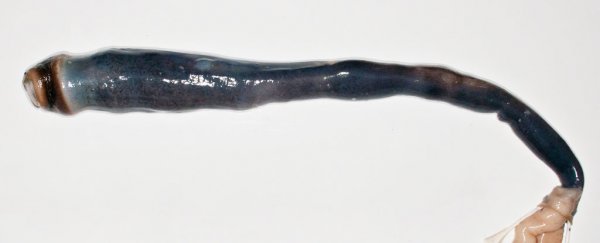For centuries, a slimy black tube-shaped creature the size of a baseball bat has been eluding scientists. They'd examined its external shell, but never laid eyes on the alien-like physique hidden inside - until now, that is.
Researchers have finally had a chance to study a living specimen of the giant shipworm (Kuphus polythalamia), which, despite its name, is not actually a worm, but a bivalve – a kind of aquatic mollusc enclosed in its shell, and a decidedly mysterious breed at that.
"It's sort of the unicorn of molluscs," marine microbiologist Margo Haygood from the University of Utah told The Washington Post.
"It's quite heavy. It's like picking up a tree branch or something even heavier. The living animal is just magnificent."

Haygood and her team encountered the first living giant shipworm specimen after a tip-off about a segment on a Philippine TV documentary, which showed numerous shipworm shells sticking out of a shallow lagoon, like carrots planted in a bizarre, muddy crop.
The animal, which grows up to about 90 centimetres (roughly 3 feet) in length, lives upside down in its shell, most of which is submerged beneath mud in shallow bays in the Philippines.
Its head and mouth are located at the base of the shell, deep within the mud – and were it not for the tell-tale tip of the shell indicating where these planted molluscs were holed up, the giant shipworm might have successfully eluded scientists for another couple of centuries.
"I've been studying shipworms since 1989 and in all that time I had never seen a living specimen of Kuphus polythalamia," says one of the researchers, Daniel Distel from Northeastern University.
"It was pretty spectacular to lift that tube out of its container for the first time. To see this giant gun-metal black specimen was amazing. On the one hand, I was pretty excited to see what it looked like inside. On the other hand it was a little intimidating to dissect this incredibly rare specimen."
Other shipworms are light in colour like clams, being white, beige, or pink. But the giant shipworm is like a dark, slick alien – and another point of difference is how it stays alive.
Unlike other species of shipworm – which burrow into timber that falls into the water, and end up digesting the wood – the giant shipworm lives off hydrogen sulphide gas produced by the mud it calls home.
It's only a hypothesis at the moment, but the team thinks the giant shipworm might once have consumed wood like its cousins, before evolving to live off sulphur compounds in the gas.
University of Utah
To pull off this trick, bacteria that live in the animal's gills use the hydrogen sulphide to produce organic carbon that feeds the shipworm.
This symbiotic relationship is enough to keep the giant shipworm alive – but the practice has left the creature's internal digestive organs shrunken from lack of use.
This survival mechanism – the same tactic employed by tube worms that live deep underwater on hydrothermal vents – explains how the giant shipworm manages to eat, given the shell it secretes covers its whole head (and mouth).
"If they want to grow, they have to open that end of that tube, so somehow dissolve or reabsorb that cap on the bottom, grow, extend the tube down further into the mud, and then they seal it off again," Distel told Nicola Davis at The Guardian.
While there's still a lot we don't understand about this captivating (and kind of disturbing) creature, now that we have a fresh lead on where to find them it's likely we'll discover a lot more.
And for the scientists involved who've been hunting the giant shipworm for decades, the result is basically mythical in proportion.
"To me it was almost like finding a dinosaur," Distel says, "something that was pretty much only known by fossils."
The findings are reported in the Proceedings of the National Academy of Sciences.
